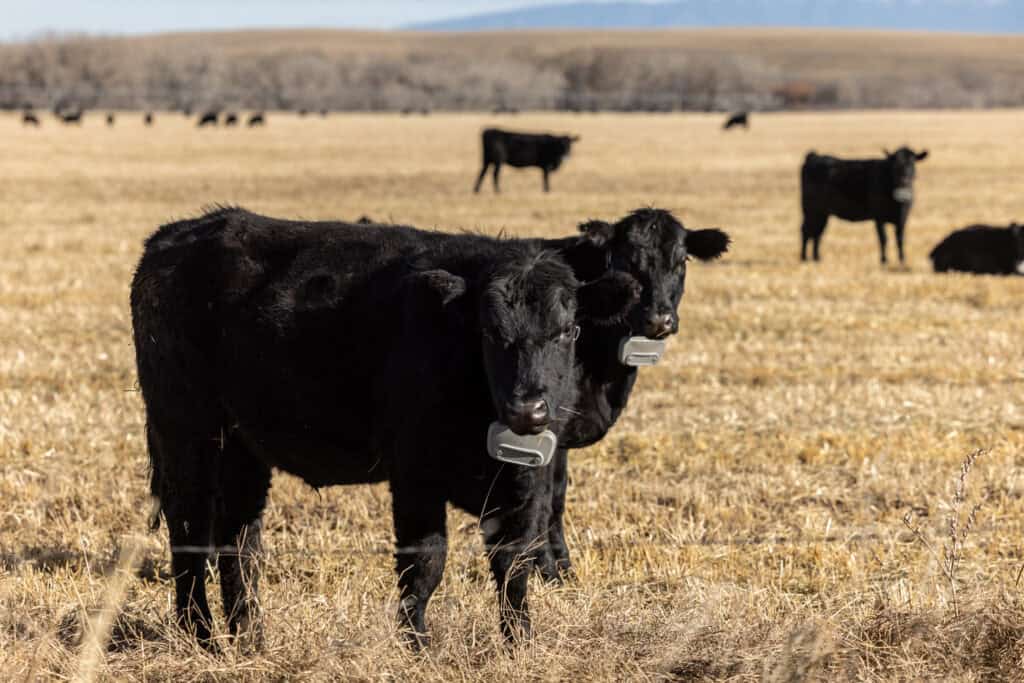
Twodot, MT—The Property and Environment Research Center (PERC) today announced a groundbreaking partnership with Montana’s McFarland White Ranch to help implement an innovative virtual fence project for cattle, a cutting-edge technology that could revolutionize both ranching and wildlife conservation.
The project will initially remove 16 of the ranch’s 75 miles of internal barbed-wire fencing and replace it with a virtual fence network that allows the rancher to remotely map and manage livestock through a series of signal towers and GPS collars worn by cows. Barbed-wire fences are a key barrier to wildlife migration throughout the West. While other projects and implementations are underway, this is the first to explicitly evaluate the technology for both migratory wildlife conservation and its effect on production agriculture—specifically, economic impact, range, and livestock benefits.
“With hundreds of thousands of miles of barbed wire fragmenting landscapes throughout the West, it’s hard to understate how transformative this project could be for wildlife,” said PERC CEO Brian Yablonski. “Virtual fence technology can help conserve open landscapes and protect wildlife migration. By eliminating the need to constantly maintain fencing, it promises to save significant time and money while offering greater flexibility, a key incentive for ranchers to adopt the approach.”
Located at the doorstep of Montana’s Crazy Mountains, the McFarland White Ranch offers ideal conditions for such a test. The ranch is home to 2,000 head of cattle, rough landscapes, and abundant wildlife. Thirty-two bird species of concern including Clark’s nutcracker, ferruginous hawk, thick-billed longspur, bobolink, sharp-tailed grouse, and sandhill cranes are found on the Audubon-certified ranch. Migratory wildlife including elk, deer, and pronghorn are also common, as well as predators such as wolves, mountain lions, and black bears.
Lanie White and her brother, Harrison, manage the ranch, and Lanie owns the Great Alone Cattle Company which directly markets cattle raised on the ranch.
“My family cares deeply for this wild land and the impacts we have,” said Lanie White. “Traditional range and animal management has included inflicting our collective will on the landscape via an instrument that is 150 years old. We are excited to be on the edge of a new paradigm. We look forward to studying the ecological and economic impacts on production agriculture as we transition from traditional to virtual fencing. The ability to pilot new technology at scale is only possible through partnerships with forward-thinking organizations like PERC. We could not be more thankful for their support.”
White began looking for an alternative after a wildfire destroyed a remote portion of internal fencing on the ranch.
Under the agreement, PERC is funding key infrastructure to implement the virtual fence and clear a path for wildlife migration, including directly purchasing one of six signal towers needed to establish a signal across the virtual network. Each solar-powered tower covers roughly 10,000 acres of range, depending on topography, and costs approximately $12,000. Cattle collars cost $50 per head per year. The ranch is seeking additional support from other conservation partners.
PERC will provide researchers to assess the project’s impact on wildlife conservation, with plans to report key findings for others to adopt and scale. The project is part of PERC’s Conservation Innovation Lab, which develops and prototypes groundbreaking models to address key conservation challenges.
How Virtual Fencing Works
Cattle are equipped with a GPS collar that emits a sound when the livestock approaches a virtual boundary, then a light shock if the animal crosses the boundary, which continues for several yards, effectively deterring cattle from entering the areas that the rancher has fenced off. Cattle need only a few days to learn that the sound from the collars means it is time for them to turn around and avoid the shock. This combination of sound and shock effectively creates a virtual boundary around the herd.
An app tracks the cattle’s location and sends alerts if the cattle attempt to leave the virtual fence boundary. External fencing will be maintained to prevent commingling with neighboring herds and comply with Montana law.
Benefits for Ranchers
Virtual fencing significantly reduces the need for traditional barbed-wire fences, bringing notable benefits:
- The virtual system allows for easily customizable boundaries.
- Ranchers can more easily track the location and status of their cattle, helping with predator control and herd management.
- Removing barbed-wire fences, which require costly and time-intensive repairs, can save ranchers considerable time and money.
Benefits for Conservation
Traditional barbed wire presents a challenge for wildlife, whose migration depends on unobstructed and expansive landscapes. Wildlife including elk and pronghorn can get caught in traditional fences, birds often fatally collide with wires, and ecologically sensitive areas are difficult to fence off with any degree of flexibility. Fences also serve as barriers that prevent wildlife from accessing habitat and reduce their winter range. For example, one study in Wyoming shows that pronghorn will only cross fences approximately 15 percent of the time, and that it can slow their migration by about 21 hours.
In addition to allowing wildlife to freely migrate, virtual fencing can also make invasive species management easier by enabling ranchers to easily “fence off” areas where invasive species need to be treated or keep animals out of areas with noxious weeds like tall larkspur, which can be fatal to livestock. Likewise, it can facilitate landscape restoration by protecting sensitive ecosystems such as wetlands, riverbanks, and streams.
“For thousands of years, stone walls were used to protect livestock around the world before barbed wire helped settlers control the American frontier,” said Travis Brammer, PERC’s director of conservation. “With today’s rapidly advancing technology, virtual fencing can help sustain traditional livestock and agriculture operations while supporting native wildlife. We’re thrilled to be partnering with the McFarland White Ranch to evaluate the technology, identify conservation outcomes, and find ways to make it financially feasible for other agricultural producers and conservation partners.”



